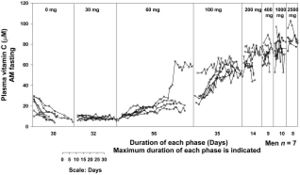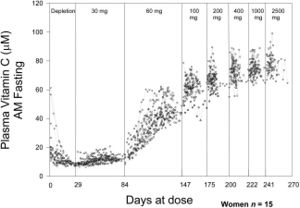Talk:Vitamin C
Sections that need to be rewritten -- JenB (talk) 22:23, September 7, 2019 (EDT)[edit source | reply | new]
Supplementation[edit source | reply | new]
Several studies indicates the recovery from Vitamin C depletion will require several months of treatment.[1] Vitamin C concentrations in plasma and circulating cells were studied in young healthy men () and women () each of whom were given six to seven different doses of the vitamin in two depletion-repletion studies. Seven healthy men (4A) and fifteen healthy women (4B), all nonsmokers, age 19-27 years were studied as inpatients. To decrease hospitalization time, outpatient subjects prior to admission were instructed to consume a diet containing < 60 mg of vitamin C. When inpatients, throughout hospitalization they consumed a defined diet containing less than 5 mg of vitamin C daily (). Deficiencies of other nutrients were prevented by supplementation. When plasma vitamin C concentrations achieved nadir of <10 µM, vitamin C in solution was administered at 15 mg orally in the fasted state twice daily (30 mg total per day) until steady state for the dose was achieved.[1]
Blood tests[edit source | reply | new]
Low blood concentration of ascorbic acid may lead to lassitude. From [1].
On blood test procedure: cited from abstract of [2]: "This chapter describes the analysis of ascorbic acid and dehydroascorbic acid in biological samples. The chapter focuses on ascorbate assays because these techniques are substantially more advanced than those for dehydroascorbic acid and most techniques for the latter are based on those of the former. High performance liquid chromatography (HPLC) with electrochemical (EC) detection is the ascorbate assay technique that provides the highest sensitivity, specificity, and accounts for substance interference. The general separation principles of HPLC are utilized to separate ascorbate from other substances. A mobile phase—or the solution for chromatography—is selected that optimizes both separation and detection. Once separation is accomplished, ascorbate is detected by one of two distinct types of EC detectors, amperometric EC detectors, or coulometric detectors. The principle of both detectors is that they pass a voltage across an area. Current generated by the voltage and the components of the mobile phase are measured. Amperometric EC detectors are “flow by” detectors, in which the solution containing ascorbate and the components of the mobile phase for HPLC separation flow around the detector. Coulometric detectors are “flow through” detectors. The mobile phase and ascorbate flow through the detector, which is porous. Coulometric detectors are preferred over amperometric detectors. The chapter concludes with a discussion of the detection of radiolabeled ascorbate and dehydroascorbic acid."



